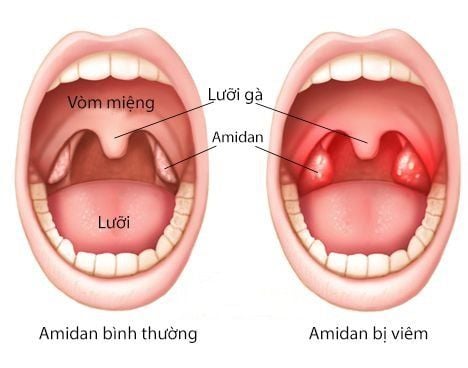This is an automatically translated article.
The article was professionally consulted by Dr. CCII Nguyen Van Thai - Department of Otolaryngology and Head and Neck Surgery, Vinmec Danang International General Hospital. Thai doctor has more than 17 years of treatment experience, especially in the field of Head and Neck Surgery.Chronic pharyngitis is a diffuse inflammation of the pharynx, very common and often associated with rhinitis, chronic sinusitis or sometimes with chronic laryngotracheobronchitis. Chronic pharyngitis manifests itself in 3 forms: exudative, exaggerated and atrophic. Lesions may be diffuse or localized.
1. Causes of chronic pharyngitis
The disease is common due to the influence of stuffy nose, prolonged mouth breathing, especially in the cold season. Due to septum deformity, nasal polyps, sinusitis, especially posterior sinusitis: mucus and pus always flow down the back of the throat. Due to stimuli such as: cigarette smoke, alcohol, dust, cotton fibers, chemicals... Due to physical factors: Body allergies, liver failure, diabetes...2. Symptoms of chronic pharyngitis
Functional symptoms:Feeling dry, hot, burning in the throat or having an itchy feeling in the throat, especially when waking up, having to try to cough up sputum, clearing the throat to loosen phlegm, flexible and thick sputum often increases when swallowing. Patients often have to spit, have little mucus, cough, especially at night, when cold, ... Swallowing trouble. The voice is hoarse for a moment and then returns to normal (drink alcohol, smoke a lot, talk a lot, the above symptoms are more obvious).

Exudative pharyngitis. Red, wet, mucous secretions of the throat, sticking to the back wall of the throat. Spitting or aspirating mucus, seeing that the back of the throat is not smooth, there are a few bloodstains and lymphoid cysts that emerge as red, masonry particles. Acute pharyngitis The mucous membrane of the throat is thick and red. At the posterior column of the tonsils, the mucosa thickens to form the pseudobulbar wall. The patient is very sensitive in the throat and very easily nauseous. The back wall of the pharynx has a strong growth of lymphoid follicles, thickening into raised, pink or red raised clusters, often called granulomatous pharyngitis. The pharynx and uvula also become thick. The throat is narrow. The Eustachian tube's mucosa is also hyperplastic, causing tinnitus. The posterior edge of the larynx is also thickened, causing a dry cough, hoarseness and a lot of secretions. Atrophic pharyngitis Over time, it turns to atrophy. Mucinous glands and neofibrotic cysts. The mucosa becomes smooth, thin, white with small blood vessels. Waist and throat wide. The mucus dries up and turns into scabs that stick to the mucous membranes, so you have to clear your throat or cough.
3. Can chronic pharyngitis be cured?
In order to treat chronic pharyngitis, it is necessary to identify the cause of the disease and eliminate the cause. Based on this, there are treatments for chronic pharyngitis as follows: Definitively treating sinusitis, tonsillitis or reflux syndromes to eliminate chronic pharyngitis. Apply topical treatments such as topical application and gargling with astringent, alkaline drugs that reduce inflammation and pain. For atrophic pharyngitis, the patient should apply and gargle with dilute iodine medicine or oil or mineral water.
4. Prevention of chronic pharyngitis
The best way to prevent sore throat is to avoid the germs that cause it and to practice good hygiene. Follow these tips and teach your child to do the same:Wash hands thoroughly and often, especially after using the bathroom, before eating, and after sneezing or coughing. Avoid sharing food, drinking glasses or utensils. Cough or sneeze into a tissue and throw it away. When necessary, sneeze into your elbow. Use alcohol-based hand sanitizer as an alternative to washing hands when soap and water are not available. Avoid touching public phones or drinking water by mouth. Regularly clean phones, TV remotes, and computer keyboards with disinfectant cleaners. When you travel, clean your phone and remote in your hotel room. Avoid close contact with people who are sick. Limit exposure to pathogens such as smoke, alcohol, and tobacco. In addition, it is necessary to improve the resistance by adding enough vitamins and nutrients to the body. Wear a protective mask in a heavily polluted place Clean teeth and gums to reduce the risk of sore throat. In addition, it is also necessary to protect the throat from pathogens by wearing masks and protective gear when working in a smoky environment. When going out, you also need to wear a mask because the pollution in the air can also cause sore throat. Drink lots of water Keep the body warm Do not share cups, spoons, chopsticks... Chronic pharyngitis affects health, interferes with daily activities and is also very difficult to treat. You should go to the doctor soon for a diagnosis as soon as there are abnormal signs in the throat area. In addition, pay attention to the habits in daily life to actively prevent chronic pharyngitis early.
Please dial HOTLINE for more information or register for an appointment HERE. Download MyVinmec app to make appointments faster and to manage your bookings easily.














